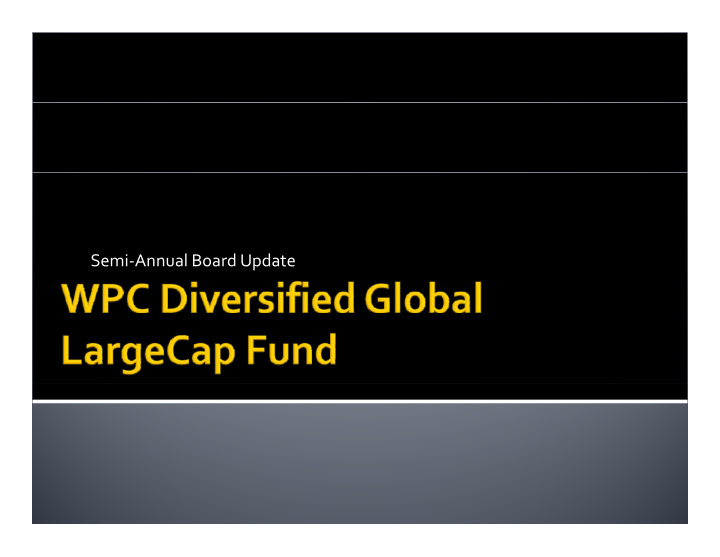



Semi ‐ Annual Board Update
Introduction I d i Portfolio engineering methodology Portfolio engineering methodology Fund composition Fund composition Performance Current economic conditions and future rebalancing b l
Fund Manager – Joe Downs Amol Agarwal Andre Shearer Andy Harper Ben Hawthorne Jameson Bennett Jon Kielmeyer Praveen Gujar j
Global diversification across asset classes f Core portfolio to preserve capital f l l Fundamental analysis overlay d l l l Learning experience
Asset Allocation Blend/Style/Focus Blend/Style/Focus Research and Gathering Data Industry Allocation F Fundamental d t l Analysis and Security Selection
Calculate Variance, Collect Historical Calculate Variance, , Expected Return, and d d Returns for the Expected Return, and Covariance for Various Universe of Asset Sharpe Ratio for Asset Classes Classes Portfolio • Charter Ch t • Priors Adjust Asset Class Asset Class Optimization Optimization WPC Gl b l Di WPC Global Diversified ifi d Weights Portfolio
Fund Composition ‐ Broad Asset Classes US Equities ‐ SPY 12% 16% 22% US Equities ‐ Individual Stocks International Funds 50% Fixed Income
Build a global diversified portfolio Gain exposure to markets with low p covariance with US equities Gain access to emerging markets Gain access to emerging markets Moderate US economic growth expectation
Research on global economic situation and individual countries Portfolio optimization to obtain initial f l b l portfolio weight Modify portfolio weight after group d f f l h f discussion Select ETFs to gain access to individual l d d l countries
Short list of ETFs that are in line with the fund’s objective j Select ETFs with five years of history Analysis of ETF holdings Analysis of ETF holdings Select ETFs with high liquidity and low expense ratios
Diversification Gain access to fixed income markets Low covariance with US equities Defensive investment in the case of Defensive investment in the case of double ‐ dip recession
Duration and average maturity Intermediate Intermediate Inflation expectations Credit quality Credit q alit I t Interest Rate Sensitivity t R t S iti it High ETF with low fees uality Credit Qu Medium VGIT Low Low Medium High
Core/satellite strategy Capital preservation Fundamental analysis and learning experience Fundamental analysis and learning experience Industry allocation y Selected industries based on optimization and priors Security selection Security selection LargeCap blend Fundamental analysis
US Equity Allocation US Equity Allocation Industrials Materials Financials 9% 24% 10% 7% Energy 9% 10% IT 12% 8% 11% Consumer Discretionary/Retail Consumer Staples Real Estate
Standard & Poor’s 500 Index – 65% MSCI Emerging Markets Index – 23% k d Barclays Capital Aggregate Bond Index – 12% l l d d
Performance Summary Total Return 1.03% Benchmark Return 3.49% Alpha ‐ 2.46% Benchmark Sharpe 0.78 Portfolio Sharpe 0.24
Attribution Metrics Asset Allocation 0.70% Security Selection ‐ 2.02% Interaction Effect ‐ 1.13%
Recession Declared Over and Economy Recovering
Jobless Claims Dropping Following Recession Jobless Claims Dropping Following Recession
Manufacturing Showing Signs of Improvement Following Recession
Moderate recovery through Q4 2010 and 2011 Overweight equities h Underweight fixed income and defensive d h f d d d f positions
Portfolio optimization/engineering process f Importance of diversification and asset f d f d allocation Bloomberg and other research tools Strength of efficient markets
8% 6% 4% 2% 2% 0% 10/4/10 10/11/10 10/18/10 10/25/10 11/1/10 11/8/10 11/15/10 11/22/10 ‐ 2% MSCI EM WFC I tl WFC Intl ‐ 4%
Interest Rate Sensitivity High i h Credit Quality Cumulative Medium Return VGIT ‐ 1.00% Barclays ‐ 0.93% Low Low Medium High
Cumulative Return MOS 19.83% FCX 15.82% GLD 4.45% WPC Mining 13.03% SPDR XME SPDR XME 15 60% 15.60%
SPDR Technology 12% WPC Technology Securities 10% 8% 6% 4% % 2% 0% 10/4/2010 10/11/2010 10/18/2010 10/25/2010 11/1/2010 11/8/2010 11/15/2010 11/22/2010 ‐ 2% ‐ 4% ‐ 6% ‐ 8%
10% SPDR Finance SPDR Fi WFC Finance 8% 6% 4% 2% 0% % 10/4/10 10/11/10 10/18/10 10/25/10 11/1/10 11/8/10 11/15/10 11/22/10 ‐ 2% ‐ 4%
10% Cumulative WPC Industrials WPC Industrials Return SPDR Industrials ETN 18.94% 8% LMT ‐ 2.97% MMM ‐ 2.36% WPC IND WPC IND 2.99% 2 99% 6% SPDR XLI 6.42% 4% 2% 0% ‐ 2% 10/4/2010 10/18/2010 11/1/2010 11/15/2010
Cumulative Cumulative Return Return SE 7.73% SE 7.73% NOV 41.61% NOV 41.61% XOM 14.38% XOM 14.38% WPC Energy 19.48% WPC Energy 19.48% SPDR XLE SPDR XLE 12 56% 12.56% SPDR XLE SPDR XLE 12 56% 12.56%
Cumulative Return TGT 6.53% HD ‐ 1.49% WPC Retail 2.20% SPDR XRT 13.86%
10% Cumulative SPDR REIT R Return WPC REIT Securities 8% VTR ‐ 0.46% PSA 0.98% WPC REIT 0.14% 6% SPDR RWR 1.98% 4% 2% 0% % 10/4/2010 10/18/2010 11/1/2010 11/15/2010 ‐ 2% ‐ 4%
Cumulative 6% Return CL 3.47% KMB ‐ 5.12% SPDR Consumer Staples 5% K ‐ 3.16% WPC Consumer Staples WPC CS ‐ 1.20% SPDR XLP 3.45% 4% 4% 3% 2% % 1% 0% 10/4/2010 10/11/2010 10/18/2010 10/25/2010 11/1/2010 11/8/2010 11/15/2010 ‐ 1% ‐ 2% ‐ 3% KMB Announces disappointing quarterly earnings
Recommend
More recommend